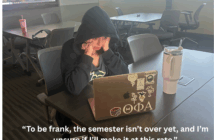By: Olivia Callahan
Fine arts education is dwindling in American primary and secondary schools.
According to the Center for Online Education, 25% of public high schools have completely rid of education of the fine arts. The pulling of arts classes and programs in schools is a shortsighted disaster. These courses are crucial and just as important as, if not more important, than subjects like math and science.
Participation in the fine arts teach students important soft skills and gives them tools that can be utilized in other areas. Young children benefit greatly in different areas from arts education. In particular, they develop fine motor skills from activities such as playing an instrument, dancing, or creating visual art.
According to the National Institutes of Health’s official website, “…developmental milestones around age three should include drawing a circle and beginning to use safety scissors.”
The fine arts are critical for older students as well.
Judith Burton, professor of art education at Columbia University, conducted a study that found that STEM subjects required “complex cognitive and creative capacities ‘typical of arts learning.’” Many studies prove that her findings show that arts education drastically improves students’ attendance and overall performance academically.
According to the National Art Assembly of State Art Agencies, “…students who took four years of arts coursework outperformed their peers who had one half-year or less of arts coursework by 58 points on the verbal portion and 38 points on the math portion of the SAT.”
In addition to improvements in the classroom, arts education also aids students in learning soft skills that are essential for their future careers. While most employers have clear material requirements for their positions (such as a college degree and work experience), what makes or breaks an applicant is usually his or her soft skills.
Entrepreneur published a list of “The 10 Unique Soft Skills Employers Desire in New Hires” that mentions skills like creativity, focus, innovation, and dependability; all of which are acquired through participation in the arts.
Exposure to the fine arts is also incredibly important for students because our society communicates through the arts.
For centuries, different art forms have been used to make powerful political and social statements. Many of these artworks have changed history and inspired different movements.
In 1939, Billie Holiday’s controversial hit “Strange Fruit” became a symbol of the protest of horrific racism at the time. Lyrics such as, “black bodies swinging in the southern breeze” are so powerful that the song has become iconic and was named “Best Song of the Century” by Time Magazine in 1999. “Strange Fruit” is only one of many artworks that has influenced history.
A more modern example of art as communication is Nilufer Demir’s shocking photograph of the deceased toddler Aylan Kurdi. This photograph is credited for illuminating the severity of the Syrian refugee crises. People internationally were moved by this photo and demanded intervention for the Syrian people. Without teaching students the fine arts, there would be no world-changing protest songs or viral photographs.
Besides education in the fine arts helping students succeed, it is also connected to their holistic health.
According to the American Journal of Public Health, “…engagement with artistic activities… can enhance one’s moods, emotions, and other psychological states as well as have a salient impact on important physiological parameters.”
Arts are even used in therapies such as music engagement, visual arts therapy, movement-based creative expression, and expressive writing.
According to the National Institute of Mental Health, 3 million adolescents have suffered one or more major depressive episodes in the past year. By providing fine arts classes for students, schools will be providing a therapeutic activity that has been proven to relieve stress and improve mental health.
It is critical for students’ health and personal development to be exposed to the fine arts. While schools nationwide are ridding fine arts education, there are different programs and organizations such as Bring Back the Music and Americans For the Arts fighting to bring it back. The hope is that school officials will begin to realize the impact of arts education and will integrate it back into the curriculum.




